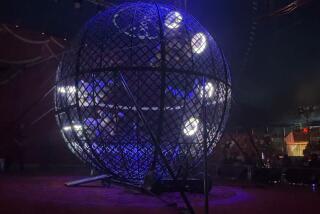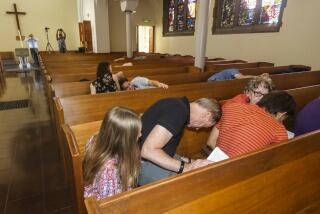Pooling Their Faith
- Share via
When the young woman learned that her baptism into the Roman Catholic Church on the night before Easter would be a thorough dousing, her reaction was short and blunt: “Aaagh!”
“You will get very wet,” Msgr. Gerald Wilkerson had advised a dozen prospective initiates, including Kirsten Arebalos, 24, at Our Lady of Grace parish in Encino as they began yearlong studies leading to their baptism, confirmation and first Communion in Easter vigil rites.
“I had a sneaking suspicion because we do have that big pool in the corner of the church,” said Arebalos, a schoolteacher, “but my husband is Catholic and he had never seen an adult baptism using a pool.”
Neither have many other Catholics. But they soon will.
To the dismay of some traditionalists, hundreds of converts to the Catholic Church in Southern California were baptized Saturday night by immersion, typically kneeling in water up to their waists as a priest poured water over their heads and shoulders.
After centuries of using only small fonts for baptizing with a small amount of water on the head, Roman Catholicism is slowly reintroducing baptismal pools into churches in order to hold immersion baptisms in a style approaching that of many Protestant churches.
The purpose: to regain the dramatic Christian symbolism of dying to the old life and rising to the new--an ancient analogy to Jesus being crucified on Good Friday and being raised from the dead on Easter.
But the baptismal pools strike some traditional Catholics as far too close to Bible Belt Protestantism.
“They ask, ‘Why are we doing it like them?’ ” said Father Rod Stephens, director of the Orange diocese office of liturgy. Similarly, a Catholic couple who displayed their company’s fast-selling, lightweight baptismal pools at the recent Religious Education Congress in Anaheim said they were offended by a few people who dropped by their booth and asked if they were really Catholics.
Generally, it has been Baptist or Pentecostal Protestant churches that fully submerge initiates in a baptismal pool--or sometimes a handy river. Episcopal, Methodist, Lutheran and other old-line Protestant churches baptize by sprinkling water on the forehead, as Catholics did.
Although Catholicism still permits such baptisms, the groundbreaking Second Vatican Council (1962-’65) decided to return to the splashier ceremony of early church history. By the 1980s, Rome deemed immersion the “more suitable” method, except for infants.
The church’s official instructions on baptism, the “Rite of Christian Initiation of Adults,” stipulate that baptismal pools be in an area of the church easily seen by the faithful and “be large enough to accommodate a good number of people.”
At least 839 initiates, called catachumens by Catholics, were to be baptized Saturday night in the Los Angeles archdiocese. Joining them in the ceremonies were additional hundreds of Catholic converts who had already been baptized in other churches, which the Catholic church accepts as valid.
It was uncertain, however, how many catachumens stepped into baptismal pools because fewer than half of the 289 parishes in the archdiocese have them so far, said Father Richard Albarano, director of the Los Angeles archdiocese’s office of worship.
“Los Angeles is probably no slower than other U.S. dioceses in making the switch,” he said. “It’s taking some time because it’s a whole different mind-set that we are trying to change.”
Said Msgr. Peter Moran of Northridge’s Our Lady of Lourdes Church: “The church moves slowly. Twenty to 30 years in church life is not long.”
*
In the Diocese of Orange, each church built since 1988 includes a permanent baptismal pool, said Stephens of the diocesan office of worship, and more than half of the diocese’s 53 parishes now have either permanent or temporary pools.
Participants wear a robe over a bathing suit or undergarments, then dry off after the dousing and put on another robe, usually white. A priest dabs a cross on their foreheads with oil, usually olive oil mixed with a perfume, as a sign of confirmation in the faith. The third, climactic step is partaking of their first Communion, the bread-and-wine ritual central to Christian worship.
Some Catholic churches have even moved to completely submerging the catachumen, as Pentecostals do. In Rowland Heights, adults are totally dunked in the large baptismal pool that St. Elizabeth Ann Seton parish built in 1990.
“The choir sings part of the ‘Hallelujah Chorus’ as they come up from the water, then they change from their long, heavy robes into white robes and carry a white candle,” said Msgr. Michael Killeen, the pastor. “This brings out far more clearly than the old way the meaning of baptism--coming out of the water cleansed and entering in the new life.”
Even in baptizing infants, some Catholic priests today have added splash to the ceremony by using more water.
While he was pastor of a Rialto parish, Father Bob Miller of the San Bernardino diocese said he often took a baby into the pool with him, immersing its whole body in water. “People like the fuller kind of symbol of baptism, and you can gather family members around the pool,” the priest said.
Despite traditionalists’ grumbling, most priests say the new rite has been well received. “I have never met anyone who has been baptized by immersion who hasn’t been totally wowed by the experience,” said Albarano.
Arebalos and her co-catechumens in the Encino parish are enthusiastic converts to the baptism style as well as to the church.
“I was thinking about being in front of all those people and wondering how I would be dressed,” Arebalos said. “But after the initial shock I really like the idea of washing my sins in a more tangible way.”
“This is the biggest moment of my life and scary because it’s such a big commitment,” said Giselle Austin, 38, of Encino. Raised in a secular Jewish family, Austin said that after a divorce she went on a 15-year spiritual quest that included drugs and Transcendental Meditation, ending the trek when a church retreat sparked her interest in Catholicism.
*
Catholic bishops and theologians say immersion highlights the importance of the baptismal ceremony, which in recent decades had become a simple rite administered to infants. In the words of Father Richard P. O’Brien, who teaches theology at the University of Notre Dame, it “could be forgotten--almost like a vaccination.”
Before the early ‘60s Vatican Council, “the common pastoral practice was that the father and the two godparents simply brought the newborn baby to church on a Sunday afternoon, without an appointment, answered a few questions by the priest and had the child baptized,” O’Brien wrote in a syndicated column.
Clergy in old-line Protestant churches are having similar misgivings about routine baptisms. “Less and less will we say yes to people who are not church members who ask if we will baptize their baby,” said the Rev. Sally Welch, president of the Southern California Ecumenical Council.
“Baptism is not a magical rite--it’s a gift that brings you into the community of faith,” said Welch, a minister in the Christian Church (Disciples of Christ).
“I think the Eastern Orthodox do it right by immersing a child in a font, holding its nose, then anointing the baby with oil, dressing it in a new, white garment and parading the child around the font,” she said.
Although parishes with older buildings usually have no immersion pools, their pastors are allowed to use portable Jacuzzis or even children’s plastic wading pools, sometimes disguised with plants and decorator stones.
Aware of the problems of temporary pools and the $30,000 to $40,000 cost of constructing a new baptismal, an Orange County priest suggested to friends Marty and Denise Menichiello that they figure out a way to build attractive but cheap pools.
“I was hoping for an aesthetic way to baptize adults other than in plastic wading pools--something with dignity,” said Father Bill Barman, pastor of Our Lady of Lourdes in Santa Ana.
The Menichiellos last year manufactured a fiberglass pool in the shape of a cross to sell for about $3,600, including a heater. After minimal advertising, their Living Waters company, based in Huntington Beach, has sold 18 pools since January to parishes from Claremont and Carpinteria to Staten Island, N.Y.
“Father Barman and I thought we might sell five by Easter, but my husband was closer with a prediction of 10 sales,” said Denise Menichiello. The priest receives 10% of the proceeds, which he says he donates to charities.
Not long after a Living Waters baptismal pool was placed in Barman’s church, the priest noticed that the pool was losing about 2 inches of water monthly even when it wasn’t being used.
Rather than finding a leak, the priest discovered that churchgoers in the mostly Latino parish were “dipping cups and empty bottles into the pool to take some of this water to bless themselves. . . . They understand in some visceral way that it is holy water.”
Repairs and renovations forced on some churches by the 1994 Northridge earthquake gave a boost to the movement toward baptismal pools. Such was the case at St. Monica’s in Santa Monica and St. Mel’s in Woodland Hills.
One problem with makeshift baptisteries: A faulty heating system can chill the solemnity of the moment.
“A couple years ago, a young man who was 13 or 14 was shivering while kneeling in water that we just couldn’t warm up,” said Bishop Armando X. Ochoa, a Los Angeles auxiliary bishop recently named to head the El Paso, Texas, diocese.
“When I poured water over his head and shoulders, I felt so bad for him.”
More to Read
Sign up for Essential California
The most important California stories and recommendations in your inbox every morning.
You may occasionally receive promotional content from the Los Angeles Times.










